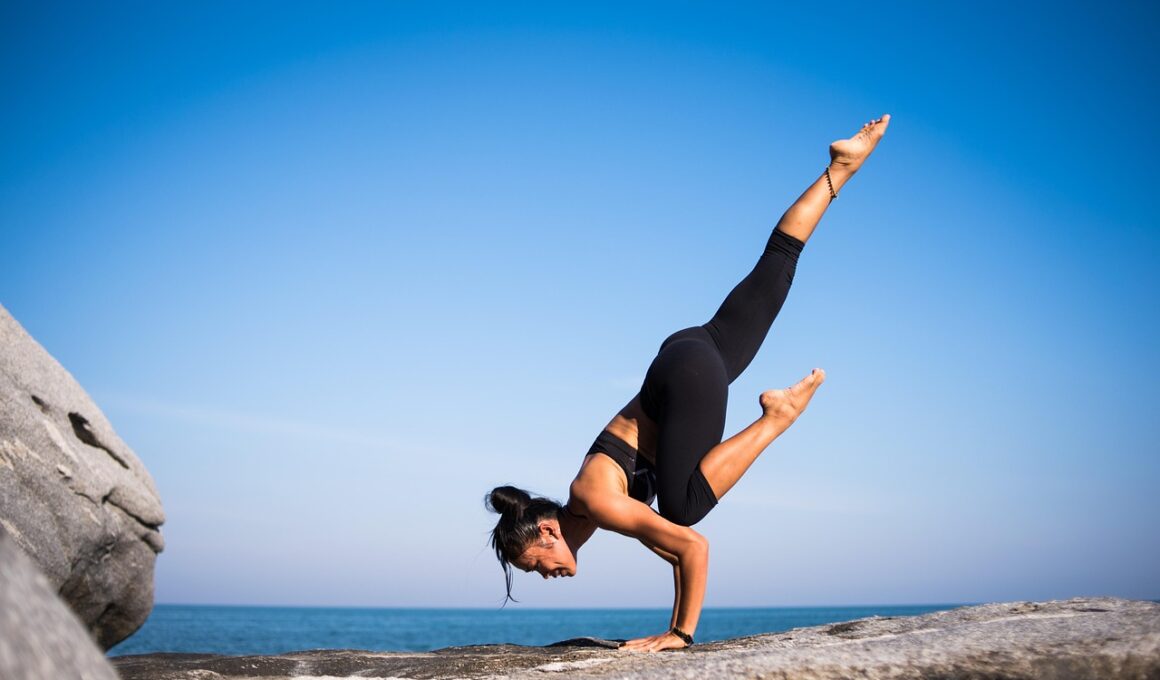Dynamic Balance Workouts for Busy Schedules
Dynamic balance workouts are essential for maintaining stability and improving overall performance. These exercises can be integrated into any daily routine, regardless of how busy life gets. One effective way to incorporate dynamic balance techniques is to perform standing movements on one leg. This might include simple activities like standing on one leg while brushing teeth or during phone calls. Moreover, utilizing objects such as balance boards can add an extra challenge, enhancing core strength and stability in a fun way. Additionally, engaging in activities such as walking lunges or side leg raises can significantly improve balance while effectively warming up the body. Routines should start with basic exercises and gradually progress to more complex movements to ensure holistic development. Moreover, using resources like instructional videos can provide an engaging way to learn these techniques at home. Regular practice, even for just a few minutes a day, can go a long way in achieving desired results. Overall, adapting dynamic balance routines can enhance coordination and flexibility, which is beneficial for both athletes and casual fitness enthusiasts alike.
One of the simplest yet most effective dynamic balance techniques is the single-leg deadlift. To perform this exercise, start by standing straight and then slowly lean your torso forward while lifting one leg behind you. It is crucial to keep your balance and maintain a straight line from the head to the raised foot. Educating on how to perform deadlifts safely is vital to prevent injuries. People tend to overlook their ankle and knee alignment, but focusing on these joints can enhance stability tremendously. Another alternative is to use resistance bands while standing; they create an element of instability that challenges balance further. By having to stabilize the core, the ancillary muscles engage perfectly. Beginners may feel more comfortable using a wall or sturdy chair for support while mastering the technique. Incorporating these exercises into your routine just twice a week can yield significant improvements in your performance over time. Progressing with weights or advancing to more challenging variations should be the long-term goal for continual improvement. Consistency and proper form will ultimately lead to better outcomes as these techniques effectively enhance dynamic balance.
A crucial aspect of dynamic balance training is ensuring variation in exercises. Different movements challenge the body in diverse ways, enhancing coordination and overall effectiveness. Incorporating activities like yoga or Pilates can also help improve not just balance but flexibility and strength as well. These mind-body practices emphasize control and core strength through dynamic movements. Additionally, practicing dynamic movements in varied environments can also yield great results. For example, challenging yourself by performing exercises on uneven surfaces, such as grass or sand, adds an extra level of difficulty. This rigorous approach develops proprioception awareness and improves balance under different conditions. With the rise of fitness applications, guided workouts can now seamlessly fit into busy schedules. Surely, testing out a new balance routine while watching television can make multitasking enjoyable and beneficial. Emphasizing social engagement by inviting friends for group workouts can spur motivation while solidifying these techniques into a fun aspect of weekly planning. It turns mundane routines into enjoyable yet productive moments. Active participation in balance training equips everyone with skills necessary to prevent injury in daily life, leading to a more resilient lifestyle.
Modifying Balance Exercises for Better Results
Modification of exercises is vital, especially when dealing with different fitness levels or restricted time periods. Individuals new to fitness should start incorporating low-impact exercises like wall sits and stoop lifts, which gradually build strength without risking injuries. Standing on a soft surface such as a pillow or mat can also serve as a balance workout. In time, as strength develops, endurance training can introduce more challenging exercises. For individuals who have certain mobility limitations, seated balance workouts can be equally effective and beneficial. These can include seated leg lifts and alternating arm reaches which maintain movement without the risk of falls. Flexibility in routines allows for a diverse approach catering to personal preferences and schedules. Time-efficient workouts are another crucial element to balance workouts for busy individuals. Short workout sessions of about 10-15 minutes can be extremely effective if done consistently. Fitness-focused apps often provide quick dynamic balance routines tailored to meet tight schedules. The key lies in commitment and finding joy in the practice, making it easier to maintain an active lifestyle while effectively incorporating balance-enhancing exercises into one’s regular regimen.
Incorporating technology into dynamic balance training can significantly enhance user experience. Many mobile applications offer tailored workout plans focused on balance and coordination, allowing users to practice anywhere, anytime. These apps often utilize timers and reminders to keep users accountable, making it easier to fit workouts into busy schedules. Additionally, virtual fitness classes incorporate live trainers leading sessions from the comfort of home, taking another look at how technology can transform fitness. Engaging with a community of like-minded fitness enthusiasts can add motivation, encouraging consistent practice. Furthermore, wearable technology like fitness tracking devices helps monitor performance and track progress. Overall, technology helps make dynamic balance training exciting and accessible for everyone. Balancing a busy schedule while trying to maintain fitness can create challenges in commitment, but utilizing available resources can genuinely facilitate these accomplishments. By creating a digital workout plan and catering it to personal objectives, everyone can work towards optimal physical health without compromising flexibility. Social media platforms can also serve as refreshing inspiration for new workouts or exercises to enhance balance. All these options create opportunities to stay connected and inspired throughout fitness journeys.
Safety Measures During Dynamic Balance Workouts
When performing dynamic balance workouts, keeping safety measures in mind is essential. One of the most effective practices is to ensure a spacious area devoid of obstructions that may cause falls or injuries. Warm-up routines before engaging in strength training not only prepare the body for dynamic movements but also reduce overall injury risk. Engaging in strength training that enhances core stability is crucial, as a strong core supports overall body balance. Additionally, wearing appropriate footwear while exercising is often overlooked; shoes with good grip can drastically impact performance and stability during workouts. Integrating rest days into a workout schedule allows for muscle recovery, further negating potential injuries. Proper hydration is equally important since dehydration can affect coordination. People must listen to their body, recognizing any signs of fatigue or discomfort that may signal a need to adjust. Furthermore, always consider individual limits—everyone progresses at their own pace, and rushing can diminish the effectiveness of workouts. Ideally, partnerships where one’s workout buddy encourages and monitors progress also serve as a sustainable approach to fitness journeys. Prioritizing safety ensures long-term success and enjoyment throughout dynamic balance training.
Ultimately, incorporating dynamic balance techniques into daily routines can significantly enhance physical health, especially for busy individuals. This emphasis on balance improves overall coordination, lowers the risk of injury, and even contributes to better posture. Busy schedules do not have to prevent fitness; instead, they should encourage more creative approaches to achieving health goals. Regular dynamic balance practice strengthens the four pillars: agility, flexibility, strength, and coordination, which are essential for mobility. Concurrently, various workouts can aid in stress reduction and enhance mood, providing mental health benefits. Finding innovative approaches to train balance becomes a source of inspiration, much more than a chore. From simple home exercises to engaging fitness classes, options abound to ensure everyone can find what suits them best. Groups and partners can create camaraderie, transforming workouts into enjoyable gatherings that enhance accountability. All individuals are encouraged to explore different techniques and find a routine that resonates, ultimately contributing to maintaining an active and resilient lifestyle. Further, as determined individuals master dynamic balance techniques, they become equipped to navigate life’s unforeseen challenges and remain balanced both physically and mentally.
In summary, whatever your experience level or schedule, there is a dynamic balance workout to fit your needs. Popular exercises encompass options like yoga, resistance training, aerobic exercises, and more. These activities can strengthen not just physical attributes but also cultivate a mindful approach to movement. For someone just starting, the journey can feel daunting, but small, manageable steps combined with regular practice will lead to substantial improvements. Try to maintain this commitment while celebrating tiny milestones along the way, reinforcing the belief in your progress. Enhancing dynamic balance benefits each person physically, mentally, and socially, impacting daily life positively. Fitness communities online offer ways to connect, share, and grow with others pursuing similar goals. By regularly assessing progress, creating boundaries around workout times, and asking for support, individuals can craft an environment conducive to success. Strengthening balance is a gradual process, but one that reaps endless rewards in promoting freedom of movement as end goals evolve. Therefore, every dynamic balance workout can instill confidence while boosting the effectiveness of everyday tasks and sports, producing an elegant cycle of continual improvement and positive health outcomes.


